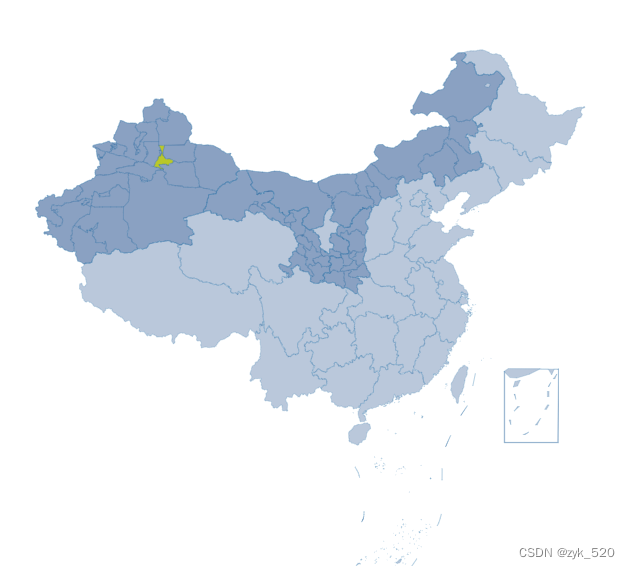一、需求背景
需要实现一个中国地图的区域图(区域级别到市),并且指定区域可以高亮。
二、相关工具
1、中国的GeoJSON数据获取:DataV.GeoAtlas地理小工具系列
2、Echart组件库 Apache ECharts
三、实现
echart配置:
const options = {
series:[{
type: 'map',
map: 'china',
roam: true, //缩放,开启缩放或者平移,可以设置成 'scale' 或者 'move', true都开启
zoom: 1, // 地图放大
aspectScale: 0.8, //地图宽高比例
nameProperty: 'name', //关联关键数据geojson数据中的关键key
emphasis: {
disabled: true //关闭高亮
},
itemStyle: {
normal: {
areaColor: 'rgba(27, 73, 135, 0.3)',
borderColor: 'rgba(58, 128, 177, 0.4)',
},
},
select: {
disabled: true
},
tooltip: {
trigger: "item",
show: true,
formatter: (params: any) => {
console.log(params)
return 'zyk';
}
},
//todo 根据添加的地点,确定data里的数据,精确到市
data: [{
name: '乌鲁木齐市',
value: 66,
//自定义特殊 tooltip,仅对该数据项有效
tooltip:{
formatter:(val:any)=>{
debugger
console.log(val)
return '666'
}
},
itemStyle: {
areaColor: 'yellow',
color: 'yellow'
}
}]
}]
}
const MyChart = echarts.init(document.getElementById("map-container"));
echarts.registerMap("china", chinaMap);
MyChart.setOption(options);关键注释:
【1】echarts.registerMap("china", chinaMap); //注册地图
// params1:map的名称,必须与options.series中的map字段一致
// params2: chinaMap,中国的GeoJSON
效果图:























 6万+
6万+











 被折叠的 条评论
为什么被折叠?
被折叠的 条评论
为什么被折叠?








